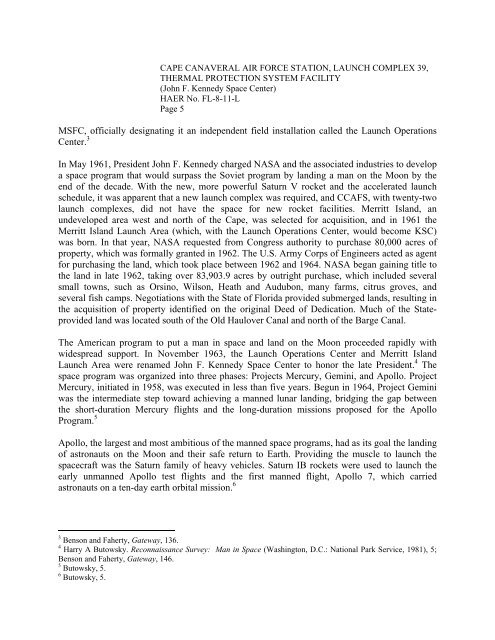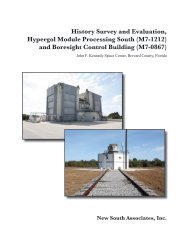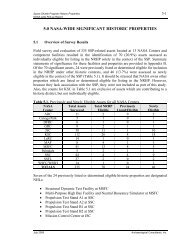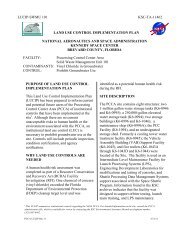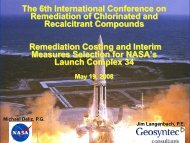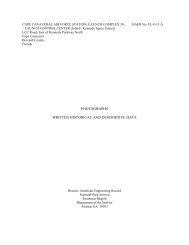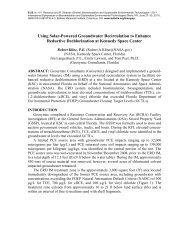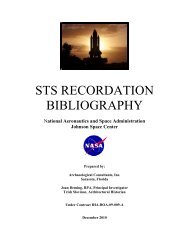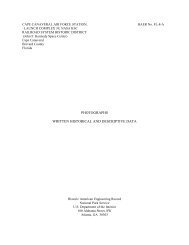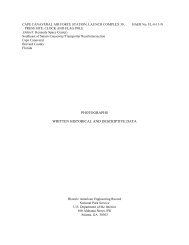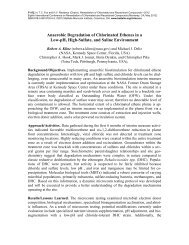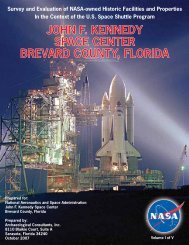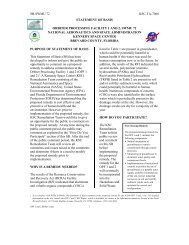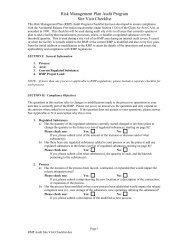Thermal Protection System Facility (TPSF) HAER - Environmental ...
Thermal Protection System Facility (TPSF) HAER - Environmental ...
Thermal Protection System Facility (TPSF) HAER - Environmental ...
Create successful ePaper yourself
Turn your PDF publications into a flip-book with our unique Google optimized e-Paper software.
CAPE CANAVERAL AIR FORCE STATION, LAUNCH COMPLEX 39,<br />
THERMAL PROTECTION SYSTEM FACILITY<br />
(John F. Kennedy Space Center)<br />
<strong>HAER</strong> No. FL-8-11-L<br />
Page 5<br />
MSFC, officially designating it an independent field installation called the Launch Operations<br />
Center. 3<br />
In May 1961, President John F. Kennedy charged NASA and the associated industries to develop<br />
a space program that would surpass the Soviet program by landing a man on the Moon by the<br />
end of the decade. With the new, more powerful Saturn V rocket and the accelerated launch<br />
schedule, it was apparent that a new launch complex was required, and CCAFS, with twenty-two<br />
launch complexes, did not have the space for new rocket facilities. Merritt Island, an<br />
undeveloped area west and north of the Cape, was selected for acquisition, and in 1961 the<br />
Merritt Island Launch Area (which, with the Launch Operations Center, would become KSC)<br />
was born. In that year, NASA requested from Congress authority to purchase 80,000 acres of<br />
property, which was formally granted in 1962. The U.S. Army Corps of Engineers acted as agent<br />
for purchasing the land, which took place between 1962 and 1964. NASA began gaining title to<br />
the land in late 1962, taking over 83,903.9 acres by outright purchase, which included several<br />
small towns, such as Orsino, Wilson, Heath and Audubon, many farms, citrus groves, and<br />
several fish camps. Negotiations with the State of Florida provided submerged lands, resulting in<br />
the acquisition of property identified on the original Deed of Dedication. Much of the Stateprovided<br />
land was located south of the Old Haulover Canal and north of the Barge Canal.<br />
The American program to put a man in space and land on the Moon proceeded rapidly with<br />
widespread support. In November 1963, the Launch Operations Center and Merritt Island<br />
Launch Area were renamed John F. Kennedy Space Center to honor the late President. 4 The<br />
space program was organized into three phases: Projects Mercury, Gemini, and Apollo. Project<br />
Mercury, initiated in 1958, was executed in less than five years. Begun in 1964, Project Gemini<br />
was the intermediate step toward achieving a manned lunar landing, bridging the gap between<br />
the short-duration Mercury flights and the long-duration missions proposed for the Apollo<br />
Program. 5<br />
Apollo, the largest and most ambitious of the manned space programs, had as its goal the landing<br />
of astronauts on the Moon and their safe return to Earth. Providing the muscle to launch the<br />
spacecraft was the Saturn family of heavy vehicles. Saturn IB rockets were used to launch the<br />
early unmanned Apollo test flights and the first manned flight, Apollo 7, which carried<br />
astronauts on a ten-day earth orbital mission. 6<br />
3 Benson and Faherty, Gateway, 136.<br />
4 Harry A Butowsky. Reconnaissance Survey: Man in Space (Washington, D.C.: National Park Service, 1981), 5;<br />
Benson and Faherty, Gateway, 146.<br />
5 Butowsky, 5.<br />
6 Butowsky, 5.


